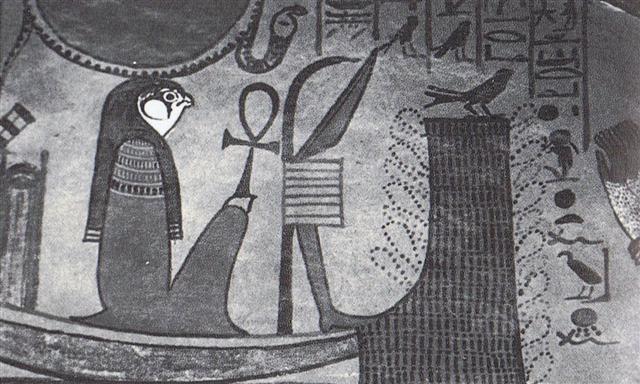Beyond
glyph 193 the text
changes character and
possibly the Sun was here
on his way down into the
Underworld, to Toga. 72 * 4 =
288 and 72 * 5 = 360:
|
Toga
1.
Winter
season.
Two
seasons
used
to
be
distinguished
in
ancient
times:
hora,
summer,
and
toga,
winter.
2.
To
lean
against
somehing;
to
hold
something
fast;
support,
post
supporting
the
roof.
3.
To
throw
something
with
a
sudden
movement.
4.
To
feed
oneself,
to
eat
enough;
e-toga
koe
ana
oho
ki
te
aga,
eat
well
first
when
you
go
to
work.
Vanaga.
1.
Winter.
P
Pau.,
Mgv.:
toga,
south.
Mq.:
tuatoka,
east
wind.
Ta.:
toa,
south.
2.
Column,
prop;
togatoga,
prop,
stay.
Togariki,
northeast
wind.
Churchill.
Wooden
platform
for
a
dead
chief:
ka
tuu
i te
toga
(Bb8-42),
when
the
wooden
platform
has
been
erected.
Barthel
2.
The
expressions
Tonga,
Kona,
Toa
(Sam.,
Haw.,
Tah.),
to
indicate
the
quarter
of
an
island
or
of
the
wind,
between
the
south
and
west,
and
Tokelau,
Toerau,
Koolau
(Sam.,
Haw.,
Tah.),
to
indicate
the
opposite
directions
from
north
to
east
-
expressions
universal
throughout
Polynesia,
and
but
little
modified
by
subsequent
local
circumstances
-
point
strongly
to a
former
habitat
in
lands
where
the
regular
monsoons
prevailed.
Etymologically
'Tonga',
'Kona',
contracted
from
'To-anga'
or 'Ko-ana',
signifies
'the
setting',
seil.
of
the
sun.
'Toke-lau',
of
which
the
other
forms
are
merely
dialectical
variations,
signifies
'the
cold,
chilly
sea'.
Fornander. |
 |
 |
 |
 |
 |
|
Ga7-20 |
Ga7-21 |
Ga7-22 |
Ga7-23 |
Ga7-24 (193) |
|
Atria (253.9) |
Tail-6 |
ι Ophiuchi
(255.3),
Grafias
(255.4) |
κ Ophiuchi
(256.2), ζ Arae
(256.5), ε Arae
(256.8), Cujam
(256.9) |
no star listed
(257) |
|
Wei,
η Arae (254.3),
DENEBAKRAB
(254.7) |
|
Ko Ruti 29 (333) |
30 |
Ko Korˇ 1 |
2 |
3 |
|
║November 25 |
26 (*250) |
27 |
28 |
29 (333) |
|
'November 2 |
3 |
4 |
5 (*229) |
6 |
|
'Ko Ruti 2 |
3 |
4 |
5 |
6 (310) |
|
"October 19 |
20 |
21 (*214) |
22 |
23 (296) |
|
no star listed
(70) |
Tabit (71.7), π▓
Orionis (71.9) |
π4 Orionis
(72.1), ο╣
Orionis (72.4),
π5 Orionis
(72.8) |
π╣ Orionis
(73.0), ο▓
Orionis (73.4),
Hassaleh (73.6),
π6 Orionis
(73.9) |
Almaaz (74.7),
Haedus I
(74.8) |
|
Vaitu Potu 30 |
31 (151) |
He Maro 1 |
2 |
3 |
|
║May 27 (*66) |
28 |
29 |
30 |
31 |
|
'May 3 |
4 |
5 (125) |
6 (*46) |
7 |
|
'Vaitu Potu 3 |
4 |
5 (125) |
6 (*46) |
7 |
|
"April 19 |
20 |
21 (111) |
22 (*32) |
23 |
 |
 |
 |
 |
 |
 |
|
Ga7-25 |
Ga7-26 |
Ga7-27 |
Ga7-28 |
Ga7-29 |
Ga7-30 (199) |

In
front of the morning
Sun 'incarnated' as
the sitting Horus
falcon - sailing
down below - there
is a strange
contraption, a
companion which - I
guess - could be the
origin of Phoenician
K:

... in the
ceremonial course of
the coming year, the
king is symbolically
transposed toward
the Lono pole
of Hawaiian divinity
... It need only be
noticed that the
renewal of kingship
at the climax of the
Makahiki
coincides with the
rebirth of nature.
For in the ideal
ritual calendar, the
kali'i battle
follows the autumnal
appearance of the
Pleiades, by
thirty-three days -
thus precisely, in
the late eighteenth
century, 21
December, the winter
solstice. The king
returns to power
with the sun.
Whereas, over the
next two days,
Lono plays the
part of the
sacrifice. The
Makahiki effigy
is dismantled and
hidden away in a
rite watched over by
the king's 'living
god', Kahoali'i
or
'The-Companion-of-the-King',
the one who is also
known as
'Death-is-Near' (Koke-na-make).
Close kinsman of the
king as his
ceremonial double,
Kahoali'i
swallows the eye of
the victim in
ceremonies of human
sacrifice ...
193 days
counted from the Hyades
door can be compared
with
193 days from January 1
(i.e. July
12), where in rongorongo
times the mortal twin
Castor rose heliacally:
|
Antares at the time of rongorongo: |
|
Rising in the east at sunset |
June 1 (152) |
0 |
0 |
|
15 days from winter solstice |
July 6 (187) |
35 |
35 |
|
Culmination at midnight |
July 11 (192) |
5 |
40 |
|
'Leap day' |
July 12 (193) |
1 |
41 |
|
Heliacal rising |
November 25 (329) |
136 |
177 |
|
Nakshatra day |
May 28 (148) |
184 |
361 |
The
Gregorian
nakshatra
night was
║May 31,
when the
Full Moon
reached the
Haedus gate.
Counted from
the Hyades
door this
was night
number 193.
But goats
manage
without
gates:

|






